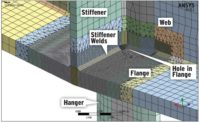AISC Calls for Steel Suppliers To Implement Electronic Purchasing

The American Institute of Steel Construction continues to drill downstream in the supply chain to ramp up e-commerce in the structural-steel sector. Though still pushing for the sharing of steel building information models between the engineer of record and the fabricator, AISC is greasing the wheels of digital automation by issuing a call for steel suppliers and producers to jump on the bandwagon of its electronic steel purchasing initiative.
"We need to advance this," said Matthew J. Gomez, national manager for construction solutions with supplier Gerdau and chairman of the AISC technical group working on the e-purchasing initiative, at AISC's 2015 North American Steel Construction Conference, held on March 25-28 in Nashville.
AISC's electronic-ordering undertaking—one of its "BIMsteel" e-commerce initiatives—is called the Common XML Schema for the Electronic Procurement of Structural Steel (steelXML). AISC collaborated with the Digital Building Laboratory at the Georgia Institute of Technology to develop the steelXML schema—a standard specification that maps the transactions and communications workflow between buyers and suppliers of structural steel.
Under the steelXML program, fabricators will no longer have to order steel by fax or an email attachment—both of which require multiple data entries. "All that time for manual data entry adds up," said Luke Faulkner, AISC's director of information technology initiatives, at the conference, which drew a record 4,582 registrants.
Suppliers also are suffering from by-hand paperwork. One supplier said that, in his shop, the sales force spends 40% to 60% of its time on data entry and re-entry.
The specification eventually will cover 10 separate bidirectional data exchanges—requests and responses—for the entire steel procurement process through the development of 17 XML schemas. The 10 exchanges are availability inquiries, price quotes, purchase orders, order status queries, advanced shipment notices, material test reports, invoices, payments, sustainability information and bills of lading.
The steelXML initiative is not yet complete. To date, schemas for availability, quote, purchase order and advanced shipment notice have been released. The rest will follow later this spring, says AISC.
Also during the conference, AISC released for public review the draft AISC 358 standard, named 2016 Prequalified Connections for Special and Intermediate Steel Moment Frames for Seismic Applications. The deadline for submitting comments for the standard, which updates the 2010 version and the 2011 and 2014 supplements, is May 11.
In the 2016 AISC 341 standard—Seismic Provisions for Structural Steel Buildings—AISC intends to include, for the first time, provisions for multi-tiered braced frames, such as industrial plants and hangars that do not have continuous floor diaphragms. The provisions are scheduled to go to the AISC specifications committee for balloting this month.
Under the steelXML initiative, fabricators that use management information system/material resource planning software from participating vendors, which to date include FabTrol Systems, FabSuite Steel Management Software, Construsoft's StruM.I.S., Ficep Corp.'s Steel Projects and Romac Computer Services Inc., will not have to do any coding to implement electronic purchasing. Only fabricators that have written their own MIS/MRP software need to add code, says Faulkner.
Currently, the five MIS/MRP vendors have implemented steelXML for availability inquiries and requests for a quote. They are testing the other schemas.
The big issue is that, to date, only three suppliers, which have to code an XML translator into their software for fabricators to use steelXML, are onboard: Gerdau, Infra-Metals and Nucor Corp.
More suppliers need to be able to accept a steelXML file, said Gomez. "The mission of developing the schema has been met," he added. "Now we have to see industry implementation."








